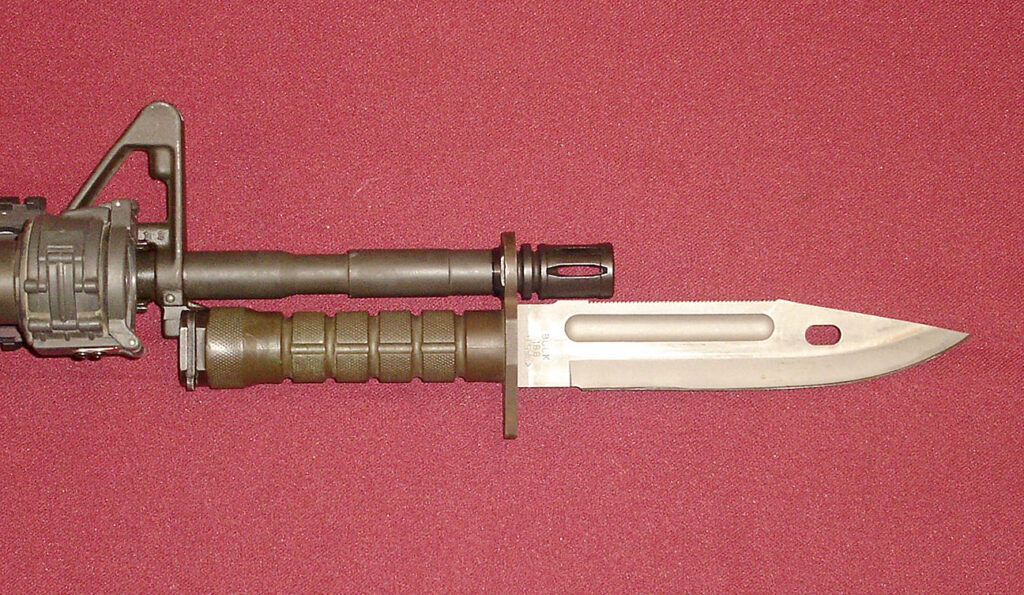The M9 bayonet was dulled by its many problems
- By Travis Pike
Share This Article

The popularity of bayonets has been declining since World War II, and even then, they were clearly on the way out with modern military forces. However, bayonets are still issued and there are stories of the British in Iraq conducting a bayonet charge, as well as of American Marines bearing bayonets in Fallujah. They were often handy to enemies at bay and useful in close quarters.
In 1986 the U.S. Army wanted troops to have a cutting implement that could be used both as a tool and a weapon. The solution was the multi-purpose M9 bayonet which replaced the M7 – a modification of the M3 trench knife.
The cutting edge
The U.S. Army tested numerous potential solutions but settled on the Qual-A-Tech M9 design. Qual-A-Tech is a fascinating company that was at the forefront of specialty military contracts.
The company’s head honcho, Mickey Finn, has been called the U.S. version of Q from James Bond. He designed the M9 and several other specialty contract items. (There is a legend that Finn retired only after Tom Clancy used his name in a novel. This inadvertently doxxed him and Qual-A-Tech which was involved in classified weapons development.)
The M9 bayonet excelled in the Army’s testing being the only candidate that passed all tests with zero failures.
The M9 was 12 inches long and had a seven-inch blade. Its knife weighed 1 pound 10 ounces with the sheath that was ALICE clip-ready. The knife had a clip point, a threaded rod tang, a set of serrations at the rear of the blade, and a very distinct hole at the front.
The U.S. adopted the bayonet, and so did Abu Dhabi, Australia, Chile, the Netherlands, New Zealand, Thailand, and India.
Anyone who has ever seen a Soviet AK bayonet would recognize the M9, as the Societ 6H3 bayonet directly inspired the M9. The latter is just bigger because this is America, and we do it bigger – especially during the Cold War!
Problems with the M9

However, the M9 has some problems that have drawn criticism from troops.
First, the M9 is a lot heavier than the older M7. The M7 weighed less than a pouch and was a smaller knife. Troops have a lot of gear and often have limited room to carry it all. The M9’s added weight and girth make a big difference.
Second, anytime you build a tactical knife, you typically want a full tang or something very close to it. Even though the KA-BAR uses a rat-tail tang, and some crash and evac knives are insulated to prevent electric shocks, a bayonet and a general infantry tool should have a full tang for strength since when you thrust a bayonet you don’t want your blade to depart from your handle.
Rather than a full tang, the M9 has a rod tang, which could be fine, but the blade and rod are a two-piece not a one-piece design, and the blade threads onto the rod tang. This creates a potential weak point.
Third, the M9’s serrations didn’t work. The serrations promised you the ability to cut through metal which could be handy as a tool, especially for crash and rescue purposes. Yet, ever since WWI, serrations have been considered cruel due to the wounds they create. So, the serrations on the M9 were neutered to avoid making the U.S. Army look bad and they ended up being more of a decoration than a useful tool. Legend has it that JAG made tons of changes because serrated bayonets are frowned upon for warfare.
Fourth, the M9’s blade had issues. One of the bragging points of the M9 was its big, thick blade. That’s great for strength but tough to sharpen; it takes a lot of effort to get a good edge on the M9. The wide and thick blade is also not the best option for a bayonet because it doesn’t penetrate as well. I wouldn’t want to be on the wrong side of one, but as a user, something like an Ontario Knife Company blade makes more sense.
The M9’s failure seems to be because it tried to do too much. It should have been a focused tool for cutting and stabbing. While the M9 isn’t terrible, there were and are way better options out there.
For the time being, the M9 remains in service although it’s being phased out. The Marine Corps ditched it in 2003 for the OKC-3S, and the Army will likely ditch it as the XM7 – the first rifle issued to a major army that doesn’t have a bayonet lug – becomes the issued rifle.
Feature Image: M9 bayonet on a rifle. (Creative Commons)
Read more from Sandboxx News
- The Long Range Desert Group and the birth of special operations around the world
- Ukraine says it busted a Russian spy ring that was gathering information about its F-16s
- 6 critical questions that will shape the future of Syria
- Starman: The Green Beret superhero who was meant to be there
- Drones swarmed a military base for days and the Pentagon still doesn’t know why
Related Posts
Sandboxx News Merch
-

‘Kinetic Diplomacy’ Bumper Sticker (Black)
$8.00 Add to cart -

A-10 ‘Warthog’ Poster
$22.00 – $28.00 Select options This product has multiple variants. The options may be chosen on the product page -

F-35 ‘Evolution’ Framed Poster
$45.00 – $111.00 Select options This product has multiple variants. The options may be chosen on the product page

Travis Pike
Travis Pike is a former Marine Machine gunner who served with 2nd Bn 2nd Marines for 5 years. He deployed in 2009 to Afghanistan and again in 2011 with the 22nd MEU(SOC) during a record-setting 11 months at sea. He’s trained with the Romanian Army, the Spanish Marines, the Emirate Marines, and the Afghan National Army. He serves as an NRA certified pistol instructor and teaches concealed carry classes.
Related to: Gear & Tech

How troops survive long deployments at sea

These were 5 outrageous uses of nuclear power during the Cold War

The French once put a cannon on a Vespa and sent it to war

Changing the Army’s mind: The M16’s long road to adoption
Sandboxx News
-

‘Sandboxx News’ Trucker Cap
$27.00 Select options This product has multiple variants. The options may be chosen on the product page -

‘AirPower’ Classic Hoodie
$46.00 – $48.00 Select options This product has multiple variants. The options may be chosen on the product page -

‘AirPower’ Golf Rope Hat
$31.00 Select options This product has multiple variants. The options may be chosen on the product page -

‘Sandboxx News’ Dad Hat
$27.00 Select options This product has multiple variants. The options may be chosen on the product page
